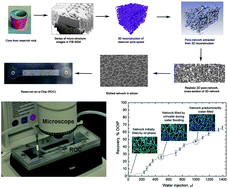Reservoir-on-a-Chip (ROC): A new paradigm in reservoir engineering†
Abstract
In this study, we design a microfluidic chip, which represents the pore structure of a naturally occurring oil-bearing reservoir rock. The pore-network has been etched in a silicon substrate and bonded with a glass covering layer to make a complete microfluidic chip, which is termed as ‘Reservoir-on-a-chip’ (ROC). Here we report, for the first time, the ability to perform traditional waterflooding experiments in a ROC. Oil is kept as the resident phase in the ROC, and waterflooding is performed to displace the oil phase from the network. The flow visualization provides specific information about the presence of the trapped oil phase and the movement of the oil/water interface/meniscus in the network. The recovery curve is extracted based on the measured volume of oil at the outlet of the ROC. We also provide the first indication that this oil-recovery trend realized at chip-level can be correlated to the flooding experiments related to actual reservoir cores. Hence, we have successfully demonstrated that the conceptualized ‘Reservoir-on-a-Chip’ has the features of a realistic pore-network and in principle is able to perform the necessary flooding experiments that are routinely done in reservoir engineering.


 Please wait while we load your content...
Please wait while we load your content...